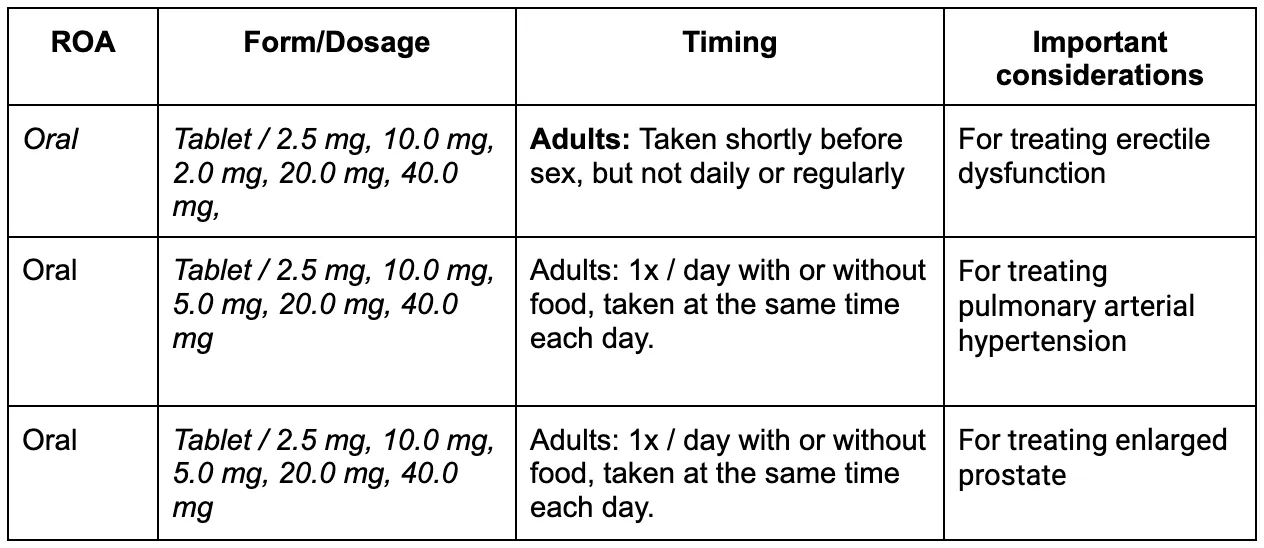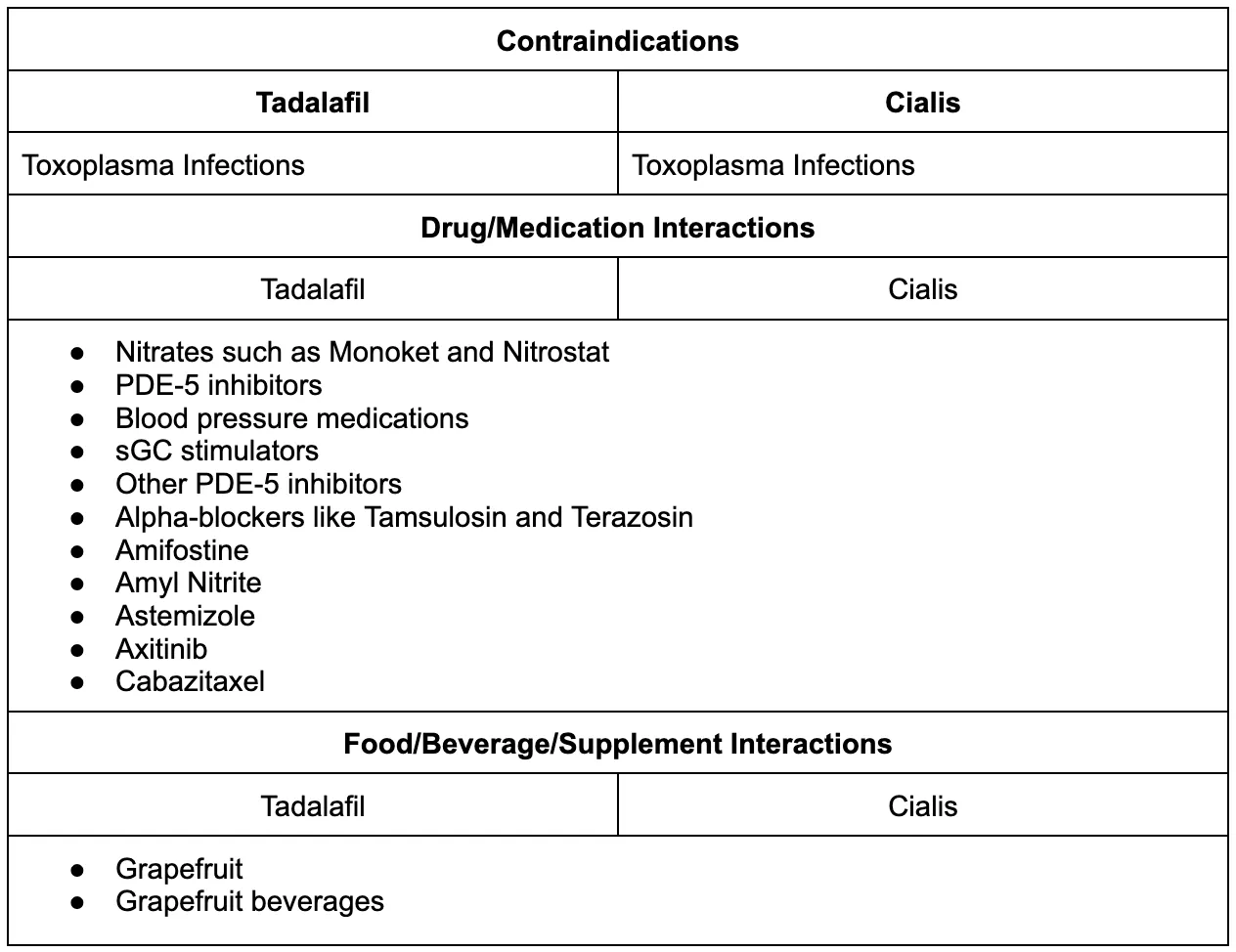Tadalafil vs Cialis
1 in 10 adult males will experience erectile dysfunction (ED) at some point in their lives. Common reasons for ED include chronic stress, drinking too much alcohol, problems in one’s private life, and extreme fatigue levels. Not eating a sufficient amount of calories can also be a reason for ED [1].
The most commonly prescribed medications for treating erectile dysfunction include Levitra (vardenafil) and Cialis (tadalafil). These medications are taken by mouth and seem to work by increasing blood flow into the penis. Erections are the result of an increase in blood flow to certain areas of the penile tissue. In general, it should take anywhere from 30 to 60 minutes for tadalafil to work [2]. These effects can last up to 36 hours. It is worth mentioning that tadalafil and similar medicines do not increase sexual arousal. In other words, they don’t have an impact on testosterone and other androgen hormones that are responsible for sexual desire.
About Tadalafil and Cialis
What is Tadalafil?
Tadalafil belongs to phosphodiesterase type 5 (PDE-5) inhibitors, a class of medications that can increase blood flow to internal areas of the penis during sexual stimulation. The increased blood flow can increase the quality of erections. Tadalafil is also used for treating pulmonary arterial hypertension, a condition that leads to high blood pressure in the lungs.
It should be noted that both tadalafil and sildenafil (the active ingredient in Viagra) work via the same mechanism. This means patients should not take the two drugs together in hopes of a synergistic effect.
What conditions is Tadalafil approved to treat?
Tadalafil is used for treating the following conditions:
- Erectile dysfunction [3]
- Pulmonary hypertension
- Benign prostate hyperplasia
Patients with pulmonary hypertension develop an increased amount of blood in the wall of the blood vessels. Tadalafil can enlarge the blood vessels, allowing blood to flow easily to the lungs. In the case of benign prostate enlargement, men can experience uncomfortable symptoms such as a constant and urgent need to urinate and dribble after urination. Tadalafil can work by increasing the levels of cyclic guanosine monophosphate (cGMP) to increase the urinary symptoms of benign prostatic hyperplasia.
How does Tadalafil work for Erectile Dysfunction?
Tadalafil is a PDE5 inhibitor, much like vardenafil and sildenafil, that completely blocks the cGMP hydrolysis of PDE5, thereby increasing the accumulation of cGMP and the relaxation of vascular smooth muscle. By controlling the PDE5 enzyme, tadalafil mains to maintain an erection in the penis. Note that this effect does not work without physical action to the penis.
Compared to sildenafil, tadalafil has a higher selectivity for PDE5 with a longer half-life, making it a more suitable solution for chronic once daily dosing in treating PAH compared to erectile dysfunction [4].
What is Cialis?
Cialis is the branded version of the generic tadalafil [5]. In other words, the active ingredient in Cialis is tadalafil, but not all medications that contain tadalafil are Cialis. Unlike tadalafil, Cialis is primarily marketed toward treating erectile dysfunction, while tadalafil is also used for treating benign prostatic hyperplasia and pulmonary hypertension. Compared to Viagra, which is arguably more popular, Cialis lasts longer for comparable doses.
What conditions is Cialis approved to treat?
Cialis is approved for treating erectile dysfunction (also known as a male impotence or the inability to keep, get or maintain an erection) and the symptoms of benign prostate hyperplasia.
How does Cialis work for Erectile Dysfunction (ED)?
The active ingredient in Cialis is tadalafil, which, as discussed earlier, increases blood flow into the penis. This allows male patients to get and maintain erections to have sexual intercourse. Cialis is available in varying levels of dosages: 2.5 mg, 5 mg, 10 mg, and 20 mg. Depending on the patient’s specific situation and what they plan on treating, they can either take the drug before sexual activity or once a day.
Note that Cialis is only available by precision and is not available over the counter. This is because doctors need to assess the patient's condition in order to make sure that Cialis is safe for them to take.
Effectiveness
How effective are Tadalafil and Cialis for treating Erectile Dysfunction?
Both Cialis and its generic variant, tadalafil, are safe and effective for treating erectile dysfunction. According to Harvard, taking an ED drug like Cialis can improve erection quality in about 70% of otherwise healthy men [6].
This means that 3 in 10 men may not be satisfied with the quality of their erections after taking Cialis.
Dosage information
How is Tadalafil administered for Erectile Dysfunction?
Tadalafil is taken as a single dose, no more than once a day, taken at the same time each day. It may be taken with or without food. The dose strength and frequency are to be determined by a doctor.
Tadalafil dosage information

How is Cialis administered for Erectile Dysfunction?
Cialis dosage information

Side Effects
This section takes a look at the list of (non-exhaustive) side effects of tadalafil and Cialis. For a detailed analysis of what side effects may or may not manifest in your case, please consult a medical doctor.
What are the most-common side effects of Tadalafil?
Patients may experience the following side effects when taking Tadalafil [7]:
- Headache
- Nausea
- Not feeling well
- Hot flushes
- Stuffy nose
- Muscle aches
- Stuffy nose
Are there any potential serious side effects of Tadalafil?
* If you experience any of these serious side effects, seek medical help immediately
- Sudden loss of vision or problems with hearing
- Prolonged or painful erection that lasts for more than 2 hours
What are the most-common side effects of Cialis?
Patients may experience the following side effects when taking Cialis [8]:
- Headache
- Muscle muscles
- Flushing
- Stuffy or runny nose
- Back pain
Are there any potential serious side effects of Cialis?
* If you experience any of these serious side effects, seek medical help immediately
- Severe dizziness
- Fainting
- Nausea
- Trouble breathing
- Swelling
Contraindications and interactions
Warnings and general precautions for Tadalafil and Cialis
Talk to your healthcare provider before you take Tadalafil or Cialis. When taking tadalafil and Cialis, do not drink excessive amounts of alcohol. This is because alcohol can increase your chances of getting a headache or dizziness. It can also increase your heart rate and lower your blood pressure.
Contraindications and important interactions for Tadalafil and Cialis

Cost Comparison
How much do Tadalafil and Cialis cost?
The price of tadalafil costs about $12 (without insurance or coupons) for 30 tablets of 5mg tadalafil. The price of Cialis depends on where you buy it and your insurance [9].
The price for Cialis, on the other hand, is around $356 for 30 tablets of 5mg of Cialis.
Popularity of Tadalafil and Cialis
Tadalafil and Cialis have had 1.6 million prescriptions in the US, with an estimated 439,516 patients. The average cost for the drug per prescription is $82, and the average out-of-pocket expenses are about $28.66.
Conclusion
Takeaway
Cialis (tadalafil) has been shown to be very effective at treating erectile dysfunction in adult male patients. The drugs can also be used for treating Benign prostate hyperplasia and pulmonary hypertension. Note that the drugs should not be combined with similar medications because they could cause severe side effects.
The generic version of Cialis, tadalafil, is cheaper and can represent significant cost savings in patients you must pay out of pocket. Cialis is well tolerated in most patients. Patients must be closely monitored by their healthcare professionals to evaluate any severe side effects.